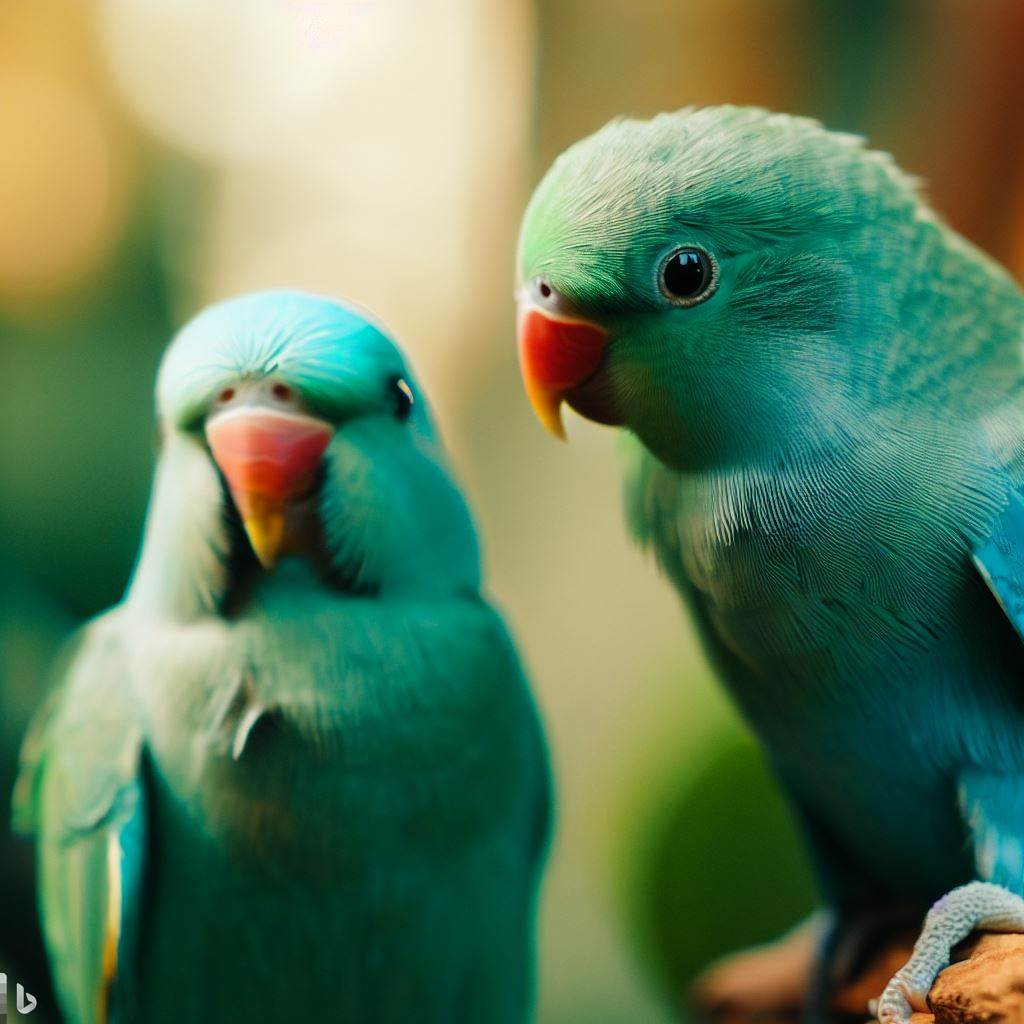Virtually unheard of several years ago, parrotlets are rapidly becoming one of the most sought-after companion parrots. Their small size, beautiful plumage, comical behavior and inability to scream are all factors which make them highly desirable as pets. Parrotlets are true parrots which means they are intelligent, bold, curious, acrobatic, can learn to talk and are capable of developing a loving bond with their owners.
There are seven species of parrotlet: Pacifics, Blue Wings, Green Rumps, Mexicans, Sclater’s, Spectacles and Yellow Face. Of these, the Pacific or Celestial and Green Rump parrotlets are the most common. Mexican and Blue Wing parrotlets are much more difficult to obtain and are rarely sold as pets. Although recent arrivals to the United States, Spectacled parrotlets are becoming more widely available due to their ease of breeding. There are only seven verified pairs of Yellow Face parrotlets in the United States although they are fairly common in Germany and Belgium. Sclater’s parrotlets have never been imported into this country and are rare even in Europe.
Less than six inches in length, parrotlets are basically tiny green hookbills. Males have blue on their heads, wings, backs and rumps, the shade and placement of which helps identify the species. Females are green with yellow on their faces, undersides and wings, the placement of which also helps identify the species although it is much more difficult in females. In only one subspecies of Pacific and in the Yellow Face parrotlet, do the females have blue on their rumps, heads and/or wings. It is best to identify the various species by the process of elimination. Spectacles, Yellow Face, Pacifics and Green Rumps have horn colored beaks and legs; Mexicans, Sclater’s and Blue Wings gray. In addition, both Yellow Face and Sclater’s have dark upper mandibles.
A hand-fed parrotlet can become a wonderful pet that is devoted to its “person”. Most are bundles of energy, spending hours swinging, climbing, playing with toys and eating. Toys that provide motion such as swings and hoops are favorites. Natural fiber ropes, leather and soft woods are appreciated as parrotlets love to chew. Fortunately, unlike most parrots, they usually do not destroy their toys due to their lack of jaw strength. Amazing acrobats, they often play with several toys at once such as hanging from a swing while chewing on a rope toy. They are in constant motion and have no problems entertaining themselves if given a wide variety of toys. Intelligent and fearless, these curious little parrots can get into a lot of trouble if they are not supervised. Parrotlets are very territorial and will attack other animals, especially other birds, even those much larger than themselves. Our pets have taken bites out of all four of our cats as well as our 80 pound golden retriever at one time or another so they give all the parrotlets a wide birth. Naturally, we discourage species interaction, however, parrotlets waste no time running up to nip a curious nose.
Both Pacifics and Green Rumps make wonderful pets if placed in their new homes at the time of weaning. Unlike many larger parrots, parrotlets do not bond with the person who is hand-feeding them. Rather, bonding is most successful when the baby is between six and nine weeks of age. As with all birds, they must be given a loving, nurturing environment with proper training and limit setting from the beginning. Since parrotlets are true parrots, closely related to Amazons, they must be cared for and trained in the same manner. It is interesting to note that, generally speaking, females tend to be one person birds and will often attack anyone but their person. Males, on the other hand, tend to have their favorite person but tolerate other people handling them.

Pacifics tend to be more feisty than Green Rumps and often strut around fearlessly. They are absolutely unafraid of any one or anything. Unfortunately, Pacifics can also be moody, jealous, territorial and develop hormonal problems during breeding season. They must also be taught limits and never be spoiled as they will turn into aggressive, biting monsters. However, most pets are very sweet and lovable birds. They will lift every feather on their body to allow petting and scratching. Most are happiest when riding around on a shoulder or in a pocket, gently preening hair or chewing on a shirt.
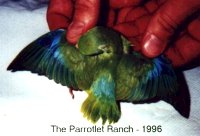
Pet Green Rumps are much more timid and shy compared to Pacifics. They are often easily frightened when confronted with any kind of new situation. Often, they will stop eating everything except millet and seed when placed in a new home. It takes much more time for them to become comfortable in their new surroundings. However, once settled in, they are just as intelligent and comical as their more assertive cousins and will swing, attack and play with their toys for hours.
Mexican parrotlets are the only parrotlets not found in Central or South America. One of the larger species, Mexicans are much less active than other parrotlets. Males have bright turquoise rumps and wings. Females have light green faces with no yellow. These parrotlets can be very difficult to breed often only producing one clutch every year or two. Most parrotlets are capable of producing multiple clutches but even when the clutch is lost Mexicans do not lay again that season. In addition to being less active, they are also much more docile than their South American counter-parts. Many hand-fed babies remain able to be handled years after becoming successful breeders which is unheard-of in other species of parrotlets. Unusually sensitive, they stop eating when stressed subjecting them to a compromised immune system often resulting in bacterial infections.
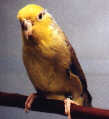
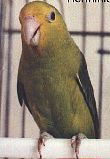
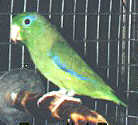
Sclater’s parrotlets have never been imported into the United States and are rare even in European aviculture. Males have darker greens and blues than another species of parrotlet. The females are somewhat lighter than the males with yellow underparts and a yellow green face.
Parrotlets kept as a single bird make the best pets. They are very active birds and need a cage that can accommodate a lot of toys. A cage 18 inches tall, 13 inches wide and 14 inches deep is the minimum recommended for a single bird. Be sure there is a grate on the bottom to keep the bird away from old food and droppings. Natural wood perches, not dowels, should be provided. Ensure that food and water is placed where they will not be soiled by droppings. Use open food dishes as parrotlets will usually not stick their heads into a dish with a hood and can starve. Water should be provided in a glass tube fountain. Often, parrotlets use their water dishes to bathe in and will splash out all of the water. If provided with a canary-size bath, they will play and splash until they are soaked. Parrotlets will also bath in wet spinach or lettuce by rolling every inch of their body on the wet leaves.
As previously mentioned, parrotlets are very active birds and require a great deal of fuel to expend so much energy. Hand-fed parrotlets should be introduced to a wide variety of foods while young. They should be fed a good-quality small hookbill or cockatiel seed mix. A large hookbill seed mix can be provided, however, parrotlets are unable to crack open the nuts often contained in these mixes. They can also be fed a commercial pelleted diet instead of seeds. Whether fed seeds or pellets, they still require fresh fruits, vegetables and greens every day. They also love whole-grain breads, potatoes, rice and pasta which should be fed several times a week. “People food” such as pizza crust, popcorn and muffins are especially relished as long as they contain little or no fat. Remember, as with all parrots, your parrotlet thinks anything you are eating is better than anything he is eating. Fresh water, mineral block and cuttlebone should be available at all times. Vitamins can be sprinkled on the fruits and vegetables.
The exact life span of parrotlets are unknown, mainly because they have been uncommon in aviculture. It is believed to be around 20 to 30 years of age. While they are not immune to avian diseases, if well-cared for, parrotlets tend to be relatively disease resistant. Breeders all over the country house these birds outdoors and successfully produce babies year after year so they are not “delicate” animals. Moreover, these birds are shipped all over the country, in all kinds of weather, with no problems.
Anyone looking for a large parrot personality in a small parrot body, need look no further than parrotlets. They are delightful little parrots whose antics can provide hours of entertainment as well as many years of devoted companionship.
Interested in more information on parrotlets? The International Parrotlet Society was founded in August 1992 to promote the proper care, breeding, showing and conservation of parrotlets. Members receive a bimonthly newsletter produced by parrotlet owners and breeders with help from several veterinarians. Each newsletter includes a color documentary photograph of parrotlets. IPS also sponsors cooperative breeding programs for several species and subspecies of parrotlets. An annual survey is taken regarding all aspects of the care and breeding of parrotlets. This information is presented to the membership for educational purposes. Dues are $25.00 per year ($30.00 international) and classified advertising is free to members.

